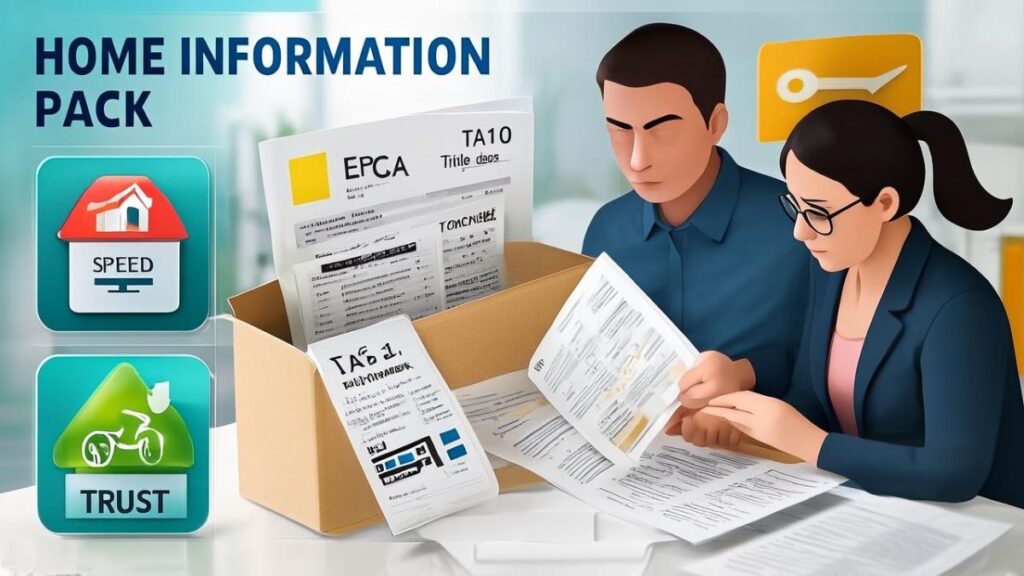In the world of real estate, transparency and preparedness are key to a smooth and efficient transaction. Whether you’re buying or selling a property, having all necessary information readily available can make the process faster, more organized, and less stressful. One tool that plays a crucial role in this context is the Home Information Pack (HIP) . Designed to streamline the home-selling process, a HIP contains essential documents and data about a property that prospective buyers can review before making an offer. While its use has evolved over time—especially after changes in legislation—it remains a valuable resource for both homeowners and buyers alike.
This comprehensive guide will walk you through everything you need to know about a home information pack , from what it includes to why it matters, how to create one, and when it’s most useful. By the end of this article, you’ll have a clear understanding of how a HIP can benefit your property journey and how to make the most of it.
What Exactly Is a Home Information Pack?
A Home Information Pack (HIP) is a collection of important documents and reports related to a residential property. It was introduced in England and Wales in 2007 as part of efforts to speed up the house-buying process by providing potential buyers with key information upfront. Although mandatory use of HIPs was abolished in 2010, many sellers still choose to prepare them voluntarily because they help build trust, reduce delays, and improve buyer confidence.
The core idea behind a HIP is simple: instead of buyers waiting for individual documents to be sent during negotiations, everything they might need to know about the property is compiled into a single, easy-to-access pack. This proactive approach not only speeds up the sale but also reduces the chance of unexpected surprises later on.
What Does a Home Information Pack Typically Include?
A standard home information pack contains several essential components. These vary slightly depending on the seller’s preferences and local requirements, but the following list outlines the most commonly included items:
- Energy Performance Certificate (EPC): Provides an energy efficiency rating for the property, along with recommendations for improvement.
- Property Information Questionnaire (TA6): Completed by the seller, this form answers questions about boundaries, disputes, planning permissions, and other legal matters.
- Fittings and Contents Form (TA10): Details which fixtures and fittings are included in the sale.
- Leasehold Information Pack (if applicable): Includes lease terms, service charge details, and management arrangements for leasehold properties.
- Title Deeds and Land Registry Documents: Proof of ownership and property registration details.
- Management Packs (for flats or leaseholds): Information on building insurance, maintenance schedules, and service charges.
- Local Authority Searches: Official records showing planning history, road schemes, and other local issues affecting the property.
- Fixtures and Fittings Inventory: A detailed list of what is staying and what is going when the property is sold.
- Building Regulation Compliance Certificates: Confirmations that any major renovations or extensions were approved and completed properly.
- Warranty Documents: For new builds or recent constructions, these provide coverage details for structural issues.
- Council Tax Band Confirmation: Shows the council tax band assigned to the property.
Some sellers may also include additional items such as:
- Floor plans
- Property photographs
- Recent utility bills
- Planning permission documents
- Guarantees for appliances or services
Below is a summary table of the typical contents of a home information pack :
Why Should You Consider Creating a Home Information Pack?
Even though preparing a home information pack is no longer legally required, there are numerous reasons why sellers should consider putting one together:
1. Speeds Up the Sale Process
Having all relevant documents ready in one place means buyers don’t have to wait for information during the conveyancing process. This can significantly reduce delays and move the transaction forward more quickly.
2. Builds Buyer Confidence
Buyers appreciate transparency. When a seller provides a complete and well-organized HIP, it signals that they’re serious and open about the property. This builds trust and makes the buyer more likely to proceed with the purchase.
3. Reduces Risk of Chain Collapse
In property chains, even minor holdups can cause significant problems. With a HIP, many potential issues are identified early, reducing the chances of last-minute complications that could derail the sale.
4. Encourages Higher Offers
Buyers who feel informed and reassured are more likely to submit competitive offers. Knowing that a HIP exists gives them peace of mind, which can translate into quicker sales and better prices.
5. Helps Avoid Legal Disputes
By clearly stating what is included in the sale and disclosing known issues upfront, sellers can minimize the risk of post-sale disputes or claims.
6. Appeals to First-Time Buyers and Investors
First-time buyers and investors often look for properties that come with clear, concise documentation. A HIP meets this need and positions your property as a hassle-free option.
How to Create Your Own Home Information Pack
Creating a home information pack doesn’t have to be complicated. Here’s a step-by-step guide to help you assemble one effectively:
Step 1: Gather All Required Documents
Start by collecting all the necessary paperwork. This includes EPCs, TA6 and TA10 forms, title deeds, and any warranties or certificates related to the property.
Step 2: Fill Out the Property Information Questionnaire (TA6)
This form asks about things like disputes with neighbors, boundary issues, planning permissions, and whether the property has ever been used for business purposes. Take your time and answer truthfully to avoid future complications.
Step 3: Complete the Fittings and Contents Form (TA10)
Clearly state what will stay with the property (e.g., built-in appliances, curtains, light fixtures) and what will go (e.g., freestanding furniture, garden tools). This helps prevent confusion later on.
Step 4: Obtain an Energy Performance Certificate (EPC)
If you don’t already have an EPC, contact a certified assessor to schedule an inspection. The EPC must be valid for ten years, so if yours is older than that, you’ll need a new one.
Step 5: Collect Leasehold or Management Information (if applicable)
For leasehold properties, obtain copies of the lease agreement, service charge statements, and any notices from the managing agent.
Step 6: Compile Everything Into a Single Pack
Organize all documents in a logical order and present them in a digital or printed format. Many sellers now choose to share HIPs digitally via email or secure online portals for convenience.
Step 7: Review and Update Regularly
If your property remains on the market for a long time, ensure your HIP remains current. Renew the EPC if needed, update the TA6 questionnaire if anything changes, and keep all documents accurate.
When Is a Home Information Pack Most Useful?
While any homeowner can benefit from creating a home information pack , there are certain situations where it becomes especially valuable:
Selling a New Build
New properties often come with warranties, construction certifications, and developer information. A HIP ensures that all these details are presented clearly to potential buyers.
Selling a Leasehold Flat
Leasehold properties involve more complex documentation, including service charges, ground rent, and lease terms. A HIP simplifies this for buyers unfamiliar with leasehold processes.
Selling After Major Renovations
If you’ve recently renovated or extended the property, including building regulation certificates and planning permissions in the HIP shows that work was done legally and safely.
Selling During a Competitive Market
When multiple buyers are interested, a well-prepared HIP can give your listing the edge. It demonstrates professionalism and readiness, making your property stand out.
Selling to First-Time Buyers or Investors
These buyers often rely heavily on documentation and clarity. Providing a HIP makes your property more attractive to these demographics.
Common Mistakes to Avoid When Preparing a Home Information Pack
Even with good intentions, some sellers make errors that can undermine the effectiveness of their home information pack . Here are some common pitfalls to watch out for:
Incomplete or Missing Documents
Leaving out critical documents like the EPC or TA6 form can delay the sale and raise red flags for buyers.
Outdated Information
An expired EPC or outdated TA6 responses can mislead buyers and require rework later on.
Unclear Fittings and Contents List
Ambiguity around what is included in the sale can lead to disputes. Be specific and honest about what stays and what goes.
Overloading with Irrelevant Information
While it’s good to be thorough, too much unnecessary detail can overwhelm buyers. Keep the pack focused on essential documents.
Poor Organization
Presenting documents in a disorganized manner can reflect poorly on the seller. Use clear headings, sections, and a logical flow.
Frequently Asked Questions About Home Information Packs
Q: Is a Home Information Pack mandatory?
A: No, since 2010, HIPs are no longer required by law in England and Wales. However, they remain highly recommended.
Q: Who prepares a Home Information Pack?
A: The seller typically prepares the HIP, often with assistance from their solicitor or estate agent.
Q: Can I sell my home without a HIP?
A: Yes, but having one can make your property more appealing and speed up the sale.
Q: How long does it take to create a HIP?
A: Depending on document availability, it can take anywhere from a few days to a couple of weeks.
Q: Do I need a new EPC every time I sell?
A: No, an EPC is valid for 10 years. If your existing EPC is still valid, you can reuse it.
Q: Are HIPs used outside the UK?
A: Similar concepts exist in other countries under different names, such as “property information packs” or “disclosure packages.”
Final Thoughts: Embracing the Value of a Home Information Pack
In today’s fast-moving real estate market, being prepared can make all the difference. A home information pack is more than just a collection of papers—it’s a strategic tool that empowers sellers and informs buyers. By taking the time to compile a comprehensive HIP, you’re not only making your property more attractive but also demonstrating professionalism and transparency.
Whether you’re a first-time seller, an experienced investor, or someone looking to downsize, a well-prepared home information pack can streamline the selling process, reduce stress, and ultimately result in a smoother, faster sale. So, the next time you’re thinking about putting your property on the market, consider creating a HIP. It might just be the key to unlocking a successful transaction.







